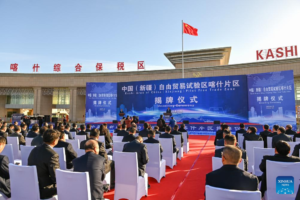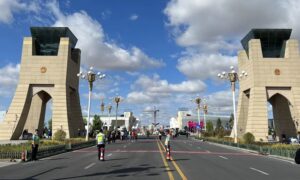
Up-grade vision and possible inclusion of third party in the CPEC Phase-II has become a “new normal” because of the rapidly changing socio-economic, geopolitical and geostrategic scenarios in the region and beyond.
Additionally, formation of Special Investment Facilitation Council (SIFC) and desire to greater economic integration with UAE, Saudi Arabia, Qatar, Kuwait and many other countries, the policy makers have also urged to think beyond “stereotype” solutions to accelerate CPEC Phase-II. Optimal utilization of “Xingjian” may be another option in this regard.
Xinjiang is willing to further expand communication and exchanges with Pakistan to further deepen practical cooperation and better benefit the people of the two countries which would be useful for the further development, expansion and connectivity orientation of the CPEC.
It sits at the heart of the Eurasia continent as well as the intersection of the CPEC and the China-Central Asia-West Asia route. It has an incomparable geographic advantage in access to massive neighbouring markets with a total population of 2.8 billion. The region is also a core area of the Silk Road Economic Belt after 10 years Of BRI Development.
Xinjiang has immense connectivity. Eastward, it could target the Asia-Pacific markets. Westward, the region is a gateway to markets in Central Asia, West Asia and the Middle East. It would also be a connecting hub for the CPEC in the days to come.
It also encourages developing China-Kyrgyzstan-Uzbekistan multimodal highway-railway transport, exploring china-Pakistan multimodal transport and the joint construction of China-Kyrgyzstan-Uzbekistan railway which would be useful for the CPEC connectivity in the Central Asia region.
It seems that Xinjiang has been at the core of China’s trade relations across the Eurasian region since the ancient Silk Road. It has strategic location in China’s westernmost frontier that borders eight countries Mongolia, Russia, Kazakhstan, Kyrgyzstan, Tajikistan, Afghanistan, Pakistan and India which gives it a comparative advantage of trans-regional connectivity, trade, transport system and, mostly importantly, human capital development.
Xinjiang is investing on expanding basic industries and infrastructure, mainly in transport, telecommunications, water conservancy, agriculture, energy development and raw material, so Pakistan should avail this opportunity to take maximum benefits from this development in these specific areas.
Pakistan through CPEC may expand its trade linkages with Central Asian and European countries through Xinjiang that offers more quick and affordable trade routes in a more peaceful and sustainable way.
The Quadrilateral Traffic in Transit Agreement (QTTA) is a transit trade deal between China, Pakistan, Kyrgyzstan and Kazakhstan for facilitating transit traffic and trade which must be institutionalized by including Xingjian region. 
First cargo assignment has been dispatched and reached to Kazakhstan by bypassing Afghanistan which has now provided an alternative route for regional connectivity and bilateral trade among Pakistan and Central Asian countries.
Xinjiang Normal University and NUML University, Islamabad has established inter-university friendly relationship. Faculties have been opened where students can study Urdu in Xinjiang Normal University.
Karamay and Gwadar, Kashgar and Hunza have become sister cities which have further enhanced prospects of trans-regional connectivity.
Pakistani agricultural technicians have already been trained in China, Xinjiang. Tashkurgan is a Sino-Pak border trade zone where Pakistanis can purchase duty-free goods up to RMB 8,000. The establishment of the special economic zones and comprehensive bonded zones for development of the CPEC is a good omen. We can exchange our expertise for development of SEZs in Pakistan
Xinjiang can support Pakistan, as it is an ideal link between the two countries, including economy, culture, agriculture and medical fields. Pakistan can export a lot of products to Xinjiang for onward supply to other provinces of China.
Xinjiang has witnessed rapid infrastructure development. Urumqi International Land Port in Xinjiang’s capital city has been built as an integrated rail, road and flight logistics hub to facilitate trade with not only the neighbouring countries but all the way up to Europe via the China-Europe Railway Express.
At present, it has a total of 19 lines, reaching 26 cities in 21 countries. The regions with relative service advantages are mainly the Central Asian region around Xinjiang, including Russia and the countries along the Caspian Sea and the Black Sea.
In summary, it is suggested that Pakistan should utilize the position of China’s Xinjiang province as an important node of the economic corridor between the two countries. Respective strengths of Gilgit Baltistan and Xinjiang should be further strengthened and systemized.
In this regard, a land border at Sost and Khunjerab should be converted into an all-weather border. Moreover, up gradation of the customs and other logistics services to facilitate trade and the movement of people would also be useful for CPEC Phase-II and Xinjiang region.
Key role of Gwadar with China’s Kashgar and Karamay regions should be further streamlined. Set up a joint agricultural demonstration zone in Xinjiang may be good move to introduce modern farming techniques and practices in Pakistan
The industries of Xinjiang and Pakistan, particularly the Gilgit-Baltistan region with focus on cooperation in solar energy should be promoted. Collaboration between the two regions in areas of culture, agriculture, tourism, education and joint research should be promoted. Formation of the China-Pakistan Air Corridor is the need of hour.
Xinjiang’s Free Trade Zone (FTZ) has further improves a service guarantee mechanism for foreign investment and support eligible foreign funded enterprises in enjoying equal access to preferential development policies.
It produces around 20 percent of global cotton, 40 percent of the world’s supply of polysilicon for solar panels, and 13 percent of the global output of wind turbines. About 25 percent of tomato paste, 11 percent of walnuts, and 10 percent of the world’s rayon also originate from here. Thus Xinjiang has become a global “manufacturing hub” and “reliable supply chain which should be used for CPEC Phase-II trans-regional connectivity.
The GDP of northwest China’s Xinjiang totaled over 854.2 billion yuan ($119.8 billion) in the first half of 2023, up 5.1 percent year-on-year, according to local authorities.
It ranked second among China’s fastest-growing provincial-level regions in terms of foreign trade in 2023, highlighting its significance as a key player in the country’s global trade network.
Trade value of Xinjiang, which holds extensive trade connections with 192 countries and regions, reached 357.33 billion yuan ($55.72 billion) last year, up almost 46 percent, outpacing the national average by 45.7 percentage points.
Its trade with Kazakhstan, Kyrgyzstan, Tajikistan, Turkmenistan and Uzbekistan grew by 50 percent in 2023 year-on-year, accounting for more than 79 percent of the region’s total foreign trade. The author is Executive Director: The Center for South & International Studies (CSAIS) Islamabad, Regional Expert: China, CPEC & BRI)







